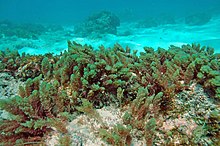Asparagopsis taxiformis
| Limukohu | |
|---|---|

| |
| Asparagopsis taxiformis in Mayotte. | |
| Scientific classification | |
| Clade: | Archaeplastida |
| Division: | Rhodophyta |
| Class: | Florideophyceae |
| Order: | Bonnemaisoniales |
| Family: | Bonnemaisoniaceae |
| Genus: | Asparagopsis |
| Species: | A. taxiformis
|
| Binomial name | |
| Asparagopsis taxiformis | |
| Synonyms | |
|
Asparagopsis sanfordiana | |
Asparagopsis taxiformis, limu kohu formerly A. sanfordiana,[1] is a species of red algae, with cosmopolitan distribution in tropical to warm temperate waters.[2]
Lifecycle
Like many red algae, A. taxiformis has a haplodiplophasic lifecycle, each phase being morphologically distinct. Indeed the species haploid haploid stage was initially described as Falkenbergia hillebrandii (Bornet) Falkenberg 1901 because it was thought to be a separate species.
Culinary uses
Asparagopsis is one of the most popular types of limu.[3] in the cuisine of Hawaii, principally as a condiment.[4] It is known as Limu kohu in the Hawaiian language meaning "pleasing seaweed".[5] Limu kohu is a traditional ingredient in poke.
The essential oil of limu kohu is 80% bromoform (tri-bromo-methane)[6] by weight, and includes many other bromine- and iodine-containing organic compounds.[4]

Methane reduction in cattle
In 2014, researchers at CSIRO and James Cook University demonstrated that feeding ruminants a diet consisting of just 1-2% percent red seaweed reduced the animals’ methane emissions by over 90 percent.[7] Of 20 types of seaweed tested, one species, Asparagopsis taxiformis, showed the most promise, with nearly 99 percent effectiveness.[8] The findings spurred interest from other leading academic and trade organizations to further investigate the effects of red seaweeds on ruminant animal production.[9] Supply from wild harvest is not expected to be adequate to support broad adoption and Asparagopsis taxiformis has yet to be commercially farmed at scale. An R&D initiative called Greener Grazing is seeking to close the life cycle of Asparagopsis taxiformis and demonstrate ocean based grow-out.[10]
See also
References
- ^ Ní Chualáin, F.; Maggs, C.A.; Saunders, G.W.; Guiry, M.D. (2004). "The invasive genus Asparagopsis (Bonnemaisoniaceae, Rhodophyta): molecular systematics, morphology, and ecophysiology of Falkenbergia isolates". Journal of Phycology. 40 (6): 1112–1126. doi:10.1111/j.1529-8817.2004.03135.x.
{{cite journal}}: Unknown parameter|last-author-amp=ignored (|name-list-style=suggested) (help) - ^ ":: Algaebase". www.algaebase.org. Retrieved 2016-10-19.
- ^ Mary Kawena Pukui; Samuel Hoyt Elbert (2003). "lookup of limu kohu". in Hawaiian Dictionary. Ulukau, the Hawaiian Electronic Library, University of Hawaii Press. Retrieved October 8, 2010.
- ^ a b B. Jay Burreson; et al. (1976). "Volatile halogen compounds in the alga Asparagopsis taxiformis (Rhodophyta)". Journal of Agricultural and Food Chemistry. 24 (4): 856–861. doi:10.1021/jf60206a040.
- ^ Mary Kawena Pukui; Samuel Hoyt Elbert (2003). "lookup of kohu". in Hawaiian Dictionary. Ulukau, the Hawaiian Electronic Library, University of Hawaii Press. Retrieved October 8, 2010.
- ^ Burreson, B. Jay; Moore, Richard E.; Roller, Peter P. (1976). "Volatile halogen compounds in the alga Asparagopsis taxiformis (Rhodophyta)". Journal of Agricultural and Food Chemistry. 24 (4): 856. doi:10.1021/jf60206a040.
- ^ Machado, Lorenna; Magnusson, Marie; Paul, Nicholas A.; de Nys, Rocky; Tomkins, Nigel (2014-01-22). "Effects of Marine and Freshwater Macroalgae on In Vitro Total Gas and Methane Production". PLoS ONE. 9 (1): e85289. doi:10.1371/journal.pone.0085289. ISSN 1932-6203. PMC 3898960. PMID 24465524.
{{cite journal}}: CS1 maint: unflagged free DOI (link) - ^ "Seaweed could hold the key to cutting methane emissions from cow burps - CSIROscope". CSIROscope. 2016-10-14. Retrieved 2018-10-01.
- ^ "Can Seaweed Cut Methane Emissions on Dairy Farms?". UC Davis. 2018-05-24. Retrieved 2018-10-01.
- ^ "Gassy cows are bad for the planet; could seaweed diet help?". AP News. Retrieved 2018-10-01.
External links
Guiry, M.D.; Guiry, G.M. "'Asparagopsis taxiformis'". AlgaeBase. World-wide electronic publication, National University of Ireland, Galway.
